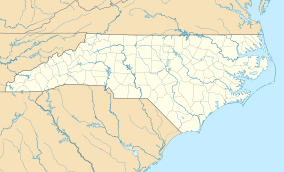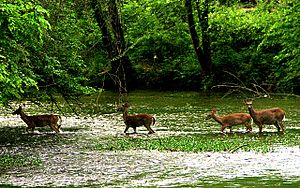Eno River State Park facts for kids
Quick facts for kids Eno River State Park |
|
|---|---|
|
IUCN Category III (Natural Monument)
|
|

Eno Park Footbridge
|
|
| Location | North Carolina, United States |
| Area | 4,319 acres (17.48 km2) |
| Established | 1975 |
| Named for | Eno River |
| Governing body | North Carolina Division of Parks and Recreation |
| Website | Eno River State Park |
Eno River State Park is a huge park in North Carolina, covering about 4,319-acre (17.48 km2)! It's located in Durham and Orange Counties. This park, along with West Point on the Eno city park, protects over 14 miles (23 km) of the beautiful Eno River and the land around it.
You can explore this park through five main entrances. Inside, you'll find 24 miles (39 km) of hiking trails, places to launch canoes, picnic spots, and even old historic buildings.
Contents
Exploring the Trails at Eno River State Park
Get ready to explore! Eno River State Park has many awesome trails for hiking. Each trail offers something special to see.
Buckquarter Creek Trail
The Buckquarter Creek Trail starts near the Piper-Cox Museum parking lot. It follows the river at Few's Ford. A staircase leads you to a great view of the Eno River rapids below. This 1.5-mile (2.4 km) loop trail is marked with red blazes. You can also connect to the Holden Mill loop and Ridge Trail from here.
Cabelands Trail
The Cabelands Trail is 1.2 miles (1.9 km) long and marked with red blazes. This trail passes by the few remaining pieces of the old Cabe Mill. The river here is very rocky and is often called Cabe's Gorge.
Cox Mountain Trail
The Cox Mountain Trail is marked with blue blazes. This 3.75-mile (6.04 km) trail goes past a picnic area. It also crosses a cool suspension footbridge! The trail climbs about 270 feet (82 m) high. Part of it follows the old Hillsborough Coach Road. As you get closer to Cox Mountain, the trail can become quite steep. This trail connects to the Fanny's Ford trail.
Eno Quarry Trail
The Eno Quarry Trail is a 0.42-mile (0.68 km) loop marked with blue blazes. In the 1960s, stone was taken from this quarry to help build Interstate 85. Now, the quarry is a 4-acre (16,000 m2) pond. This trail has several good spots if you enjoy fishing.
Eno Trace Nature Trail
Eno Trace is a nature trail with special information signs. These signs point out different kinds of wildlife you might see. There's a short set of steps, and at one point, the trail walks right alongside the river.
Fanny's Ford Trail
Fanny's Ford Trail is a 1.01-mile (1.63 km) loop. It is mostly flat with some gentle hills. This trail is near the Cox Mountain trail and Hillsborough Coach Road. It also passes through the area of the old Few Mill's race. The trail is marked with purple blazes.
Holden Mill Trail
The Holden Mill trail is made up of two loops and is 2.6 miles (4.2 km) long. The larger eastern loop follows the river for almost a mile. Then it climbs about 250 feet (76 m) high. The smaller loop goes around the remains of Holden's Mill. It also follows the river in some parts. This trail is marked with yellow blazes.
Shakori Trail
The Shakori Trail is a scenic 1.04-mile (1.67 km) hike. It is marked with yellow U-shaped blazes. Hikers can see the remains of a house from the 1800s. You can also find an old saw mill site. The trail has a 200-foot (61 m) change in elevation.
Laurel Bluffs Trail
This trail starts where it meets the Pump Station Trail. It goes east towards Guess Road. It is 2.49 miles (4.01 km) long. The trail usually stays close to the river. However, cliffs and bluffs sometimes make it go up onto ridges. Along the way, you'll see the chimney and foundation of an old hunting lodge. You can also find the mostly intact Guess Mill Dam. The trail enters the millrace and comes out at the chimney of the Guess Mill site. There are plans to extend this trail to connect with Cabelands Trail and West Point on the Eno city park trails. This connection will be part of the Mountains-to-Sea Trail.
Pump Station Trail
The Pump Station Trail is known for having the best spring wildflowers in the park. It starts at the Nancy Rhodes Creek bridge on Rivermont Road. It makes a 1.5 miles (2.4 km) loop. This is usually an easy hike with only a few gentle hills. The foundations of Durham’s first water pumping station are near the river. You can find them in the northeast part of the loop.
A Look Back: History of Eno River State Park
Native American Life Along the Eno
Long ago, Native American tribes lived along the Eno River. These included the Eno, Shakori, and Occoneechee tribes. Some of these tribes joined together in the late 1600s. They built a village near what is now Durham.
Early Settlers and Mills
Later, settlers moved to the area. They started farms and built gristmills. Gristmills used the river's power to grind grain into flour. More than thirty mills were once located on the Eno River! By the 1940s, the last of these mills stopped working.
Saving the Eno River
In 1965, the city of Durham wanted to build a reservoir in the river valley. A reservoir is like a big lake that holds water for a city. Many people were worried about this plan. They wanted to protect the Eno River. So, they started a group called the Association for the Preservation of the Eno River Valley. This group worked hard to save the river. They suggested creating a state park. In May 1972, North Carolina agreed to the idea! In 1975, the state bought over 1,000 acres (4.0 km2) of land for the park. They had help from the Eno River Association and the Nature Conservancy.
The Eno River Association: Protecting the Park
The Eno River Association was started in 1966. This group played a very important part in creating Eno River State Park. Since it began, the association has bought over 4,900 acres (20 km2) of land for the park. They also help people learn about protecting nature.
One big event they put on is the annual Festival for the Eno. This festival brings about 30,000 visitors over three days in July. The festival has music, crafts, food, and teaches people about caring for the environment. The money raised at the festival helps fund the Eno River Association's important work.





